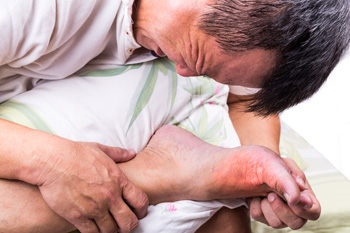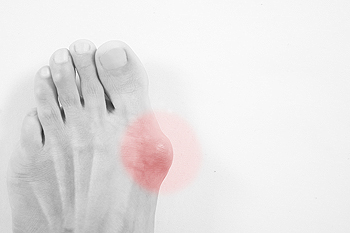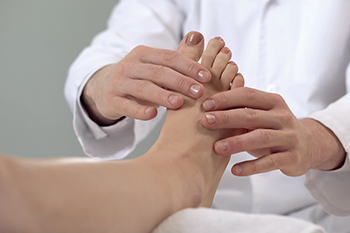September 2022
What Does the Cuboid Bone Do?

There are many bones located in the foot that each play an important role in helping the foot function and move properly. The cuboid bone is one such bone. Located on the outer side of the foot in the midfoot area, this small bone is almost cubical in shape. It is critical to the foot because not only does it provide stability, it also facilitates sufficient weight distribution throughout the feet. It is important to note that the cuboid bone additionally aids in toe movement. A number of ligaments are also attached to the cuboid bone, including the birfurcate ligament and the cuboideonavicular ligament. The cuboid bone alone does not usually fracture by itself in the foot. However, it is susceptible to a condition known as cuboid syndrome, which can move the bone out of alignment. If you want to learn more about the cuboid bone, make an appointment with your local podiatrist today.
If you have any concerns about your feet, contact Dr. John C. Lawlor from Florida. Our doctor can provide the care you need to keep you pain-free and on your feet.
Biomechanics in Podiatry
Podiatric biomechanics is a particular sector of specialty podiatry with licensed practitioners who are trained to diagnose and treat conditions affecting the foot, ankle and lower leg. Biomechanics deals with the forces that act against the body, causing an interference with the biological structures. It focuses on the movement of the ankle, the foot and the forces that interact with them.
A History of Biomechanics
- Biomechanics dates back to the BC era in Egypt where evidence of professional foot care has been recorded.
- In 1974, biomechanics gained a higher profile from the studies of Merton Root, who claimed that by changing or controlling the forces between the ankle and the foot, corrections or conditions could be implemented to gain strength and coordination in the area.
Modern technological improvements are based on past theories and therapeutic processes that provide a better understanding of podiatric concepts for biomechanics. Computers can provide accurate information about the forces and patterns of the feet and lower legs.
Understanding biomechanics of the feet can help improve and eliminate pain, stopping further stress to the foot.
If you have any questions please feel free to contact one of our our offices located in Cape Coral and LaBelle, FL . We offer the newest diagnostic and treatment technologies for all your foot and ankle needs.
Gout and How It Affects the Feet

Gout is a type of inflammatory arthritis that can cause severe pain in and around affected joints, often in the big toe. Gout is most common in older men. Symptoms include swelling, redness, tenderness, and severe pain in the affected joint. This condition, left untreated, can worsen. Gout attacks usually occur on the joint at the base of the big toe, but can affect every other joint in the foot. Many joints can be affected at once. Attacks happen quickly and can become worse. They may subside after a week or take longer to to heal. The primary cause of gout is an accumulation of uric acid in the body. This happens because of the breakdown of chemicals in the body known as purines. Usually, uric acid is secreted through the kidneys and urine, but when it is not, the substance begins to form crystals, which settle around joints, under skin, and even in internal organs. Eventually they find their way into spaces between bones that form a joint and begin to rub against joint linings, causing pain and inflammation. If you feel pain in your big toe, please see a podiatrist who can properly diagnose gout and provide appropriate treatment.
Gout is a foot condition that requires certain treatment and care. If you are seeking treatment, contact Dr. John C. Lawlor from Florida. Our doctor will treat your foot and ankle needs.
What Is Gout?
Gout is a type of arthritis caused by a buildup of uric acid in the bloodstream. It often develops in the foot, especially the big toe area, although it can manifest in other parts of the body as well. Gout can make walking and standing very painful and is especially common in diabetics and the obese.
People typically get gout because of a poor diet. Genetic predisposition is also a factor. The children of parents who have had gout frequently have a chance of developing it themselves.
Gout can easily be identified by redness and inflammation of the big toe and the surrounding areas of the foot. Other symptoms include extreme fatigue, joint pain, and running high fevers. Sometimes corticosteroid drugs can be prescribed to treat gout, but the best way to combat this disease is to get more exercise and eat a better diet.
If you have any questions please feel free to contact one of our our offices located in Cape Coral and LaBelle, FL . We offer the newest diagnostic and treatment technologies for all your foot and ankle needs.
Various Reasons Why Bunions May Develop

The common foot condition known as a bunion can be unflattering. It is a deformity that affects approximately 30% of the population. A bunion is defined as a bony lump that forms on the side of the big toe. Research has shown it can develop from genetic reasons or possibly from the shoes that are worn. Many people wear shoes that do not have adequate room for the toes to move freely in, and a bunion may start to form. Additional reasons why a bunion can occur include enduring an injury that may alter the structure of the foot. This may contribute to having damaged ligaments, and can cause a misalignment of the big toe. If the bunion is large, it may cause the big toe to shift toward the other toes, and this can cause pain and discomfort. Patients often need to purchase larger shoes that can accommodate the bunion, and it is suggested that medical attention is sought. There are several treatment options for bunions, and if you are afflicted with one, it is strongly advised that you contact a podiatrist who can guide you toward the best one for you.
If you are suffering from bunion pain, contact Dr. John C. Lawlor of Florida. Our doctor can provide the care you need to keep you pain-free and on your feet.
What Is a Bunion?
Bunions are painful bony bumps that usually develop on the inside of the foot at the joint of the big toe. As the deformity increases over time, it may become painful to walk and wear shoes. Women are more likely to exacerbate existing bunions since they often wear tight, narrow shoes that shift their toes together. Bunion pain can be relieved by wearing wider shoes with enough room for the toes.
Causes
- Genetics – some people inherit feet that are more prone to bunion development
- Inflammatory Conditions - rheumatoid arthritis and polio may cause bunion development
Symptoms
- Redness and inflammation
- Pain and tenderness
- Callus or corns on the bump
- Restricted motion in the big toe
In order to diagnose your bunion, your podiatrist may ask about your medical history, symptoms, and general health. Your doctor might also order an x-ray to take a closer look at your feet. Nonsurgical treatment options include orthotics, padding, icing, changes in footwear, and medication. If nonsurgical treatments don’t alleviate your bunion pain, surgery may be necessary.
If you have any questions, please feel free to contact one of our our offices located in Cape Coral and LaBelle, FL . We offer the newest diagnostic and treatment technologies for all your foot care needs.
Heel Pain Can Be Treated!
High Heels and Ankle Sprains

High heels are undoubtedly a significantly popular footwear fashion choice made by women across the world. Despite their popularity, excessive use of high heels can wreak havoc on your feet. Due to their structure which features a narrow toe box, high heels can cause a variety of foot ailments that you ought to be aware of. Besides just causing foot pain, high heels can also lead to lower back pain and knee pain. In particular, high heels have a damaging tendency of making one susceptible to ankle sprains. When high heels are worn on uneven surfaces (i.e. cobblestone), the chances of falling or tripping increase markedly. If an individual falls while wearing high heels, they may land awkwardly on their ankle or twist it in some way, eventually suffering from an ankle sprain. Falling in this way might also lead to broken ankles and perhaps bruised knees. To avoid suffering these injuries, one might consider walking with high heels only on even surfaces. Additionally, one could consider limiting the time that they spend wearing this kind of footwear. It is simply an unfortunate truth that, like flip flops, high heels can be a potentially damaging kind of footwear. If you are worried about how high heels affect your feet, consult with your local podiatrist.
High heels have a history of causing foot and ankle problems. If you have any concerns about your feet or ankles, contact Dr. John C. Lawlor from Florida. Our doctor can provide the care you need to keep you pain-free and on your feet.
Effects of High Heels on the Feet
High heels are popular shoes among women because of their many styles and societal appeal. Despite this, high heels can still cause many health problems if worn too frequently.
Which Parts of My Body Will Be Affected by High Heels?
- Ankle Joints
- Achilles Tendon – May shorten and stiffen with prolonged wear
- Balls of the Feet
- Knees – Heels cause the knees to bend constantly, creating stress on them
- Back – They decrease the spine’s ability to absorb shock, which may lead to back pain. The vertebrae of the lower back may compress.
What Kinds of Foot Problems Can Develop from Wearing High Heels?
- Corns
- Calluses
- Hammertoe
- Bunions
- Morton’s Neuroma
- Plantar Fasciitis
How Can I Still Wear High Heels and Maintain Foot Health?
If you want to wear high heeled shoes, make sure that you are not wearing them every day, as this will help prevent long term physical problems. Try wearing thicker heels as opposed to stilettos to distribute weight more evenly across the feet. Always make sure you are wearing the proper shoes for the right occasion, such as sneakers for exercising. If you walk to work, try carrying your heels with you and changing into them once you arrive at work. Adding inserts to your heels can help cushion your feet and absorb shock. Full foot inserts or metatarsal pads are available.
If you have any questions please feel free to contact one of our our offices located in Cape Coral and LaBelle, FL . We offer the newest diagnostic and treatment technologies for all your foot and ankle needs.









